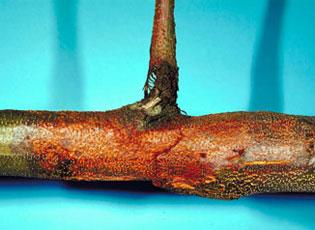Cryphonectria parasitica (Murrill) Barr (formerly known as Endothia parasitica) (ITIS)
Chestnut blight, chestnut bark disease
Asia (Anagnostakis 1997)
First discovered in 1904 (Anagnostakis 1997)
Introduced on nursery stock imported from Asia (Anagnostakis 1997)
Fungal disease of chestnut trees (Castanea spp.) that virtually eliminated mature American chestnuts (Castanea dentata) from the U.S. (Griffin 2000)
Widespread throughout the U.S.

Chestnut blight symptoms
Photo by Robert L. Anderson; USDA. Forest Service
Spotlights
Distribution / Maps / Survey Status
Videos
All Resources
Selected Resources
The section below contains highly relevant resources for this species, organized by source.
Partnership
Federal Government
International Government
State and Local Government
Academic
Anagnostakis, S.L. 1997. Chestnuts and the Introduction of Chestnut Blight. Connecticut Agricultural Experiment Station.
Griffin, Gary J. 2000. Blight control and restoration of the American chestnut. Journal of Forestry 98(2):22-27.
Integrated Taxonomic Information System. Cryphonectria parasitica. [Accessed Aug 20, 2023].
